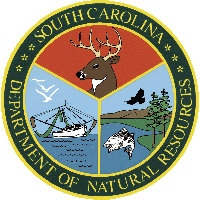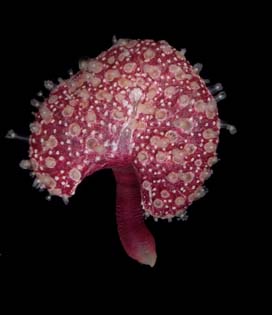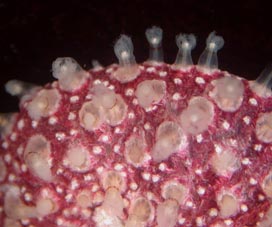CONTENTS
Introduction
The South Atlantic Bight
Methods
Octocoral Morphology
Glossary
Gorgonacean
Bauplan
see this for keys
Notes on the Species
Carijoa
riisei
Scleranthelia
rugosa
Telesto fruticulosa
Telesto nelleae
Telesto sanguinea
Bellonella rubistella
Pseudodrifa nigra
Nidalia occidentalis
Iciligorgia schrammi
Diodogorgia
nodulifera
Titanideum
frauenfeldii
Muricea pendula
Thesea nivea
Bebryce cinerea
Bebryce parastellata
Scleracis guadalupensis
Paramuricea sp.
Leptogorgia hebes
Leptogorgia punicea
Leptogorgia
cardinalis
Leptogorgia virgulata
Leptogorgia setacea
Leptogorgia euryale
Viminella
barbadensis
Renilla reniformis
Sclerobelemnon
theseus
Stylatula elegans
Virgularia presbytes
| Guide
to the Shallow Water (0-200 m) Octocorals of the South Atlantic
Bight.
S. T. DeVictor
& S. L. Morton, 2007
Renilla reniformis
(Pallas, 1766) Remarks. This species is easily
recognizable as the only leaf-shaped octocorallian in the shallow
South Atlantic Bight, and is well described by its familiar name,
“sea pansy”. The frond (oozooid) is approximately
as wide as it is long, with polyps (autozooids and siphonozooids)
restricted to the upper surface. Sclerites are in the form of three
flanged rods, which are longer in the frond than in the stalk. The
color of the colonies includes varying shades of rose and purple. Atlantic distribution: North Carolina to Brazil,
Caribbean, 1-72 m (Deichmann, 1936; Bayer, 1961; NMNH collections;
SERTC collection).
|
|
 |

